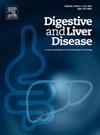成功治疗肝移植受者hhv -8相关的原发性积液性淋巴瘤和KICS:一例报告
IF 3.8
3区 医学
Q1 GASTROENTEROLOGY & HEPATOLOGY
引用次数: 0
摘要
人类疱疹病毒8 (HHV-8),也被称为卡波西肉瘤相关疱疹病毒(KSHV),是一种致癌病毒,导致几种罕见的淋巴细胞增生性疾病。虽然其对hiv阳性个体的影响有充分的文献记载,但关于其在实体器官移植(SOT)受者中的行为和临床后果的数据仍然很少。原发性积液性淋巴瘤(PEL)和KSHV炎性细胞因子综合征(KICS)在这种情况下特别罕见且通常是致命的并发症。病例报告:一名56岁男性因酒精性肝硬化合并难治性腹水于2024年2月接受原位肝移植(OLT),在循环性死亡(DCD)后接受供体移植。受体HHV-8血清学阴性;供者血清状态未知。免疫抑制包括他克莫司和类固醇。患者于2024年6月因发热、疲劳、黄疸、体重增加、胆汁淤积、炎症标志物升高、贫血和低钠血症等实验室证据入住我院。CT及MRI显示双侧肺浸润、腹水及脾肿大,排除胆道狭窄。HHV-8 DNA为32156拷贝/mL, EBV DNA为739拷贝/mL, CMV DNA未检出。经颈静脉肝活检显示噬血细胞特征;骨髓活检排除了HLH和淋巴细胞增生性疾病。穿刺显示单克隆质母细胞HHV-8 LANA-1阳性,确认PEL的诊断(图1)。患者符合KICS标准。停用他克莫司,代之以依维莫司。利妥昔单抗治疗导致HHV-8病毒血症的快速临床改善和下降。化疗以CVP开始,后来由于临床状况恶化升级为R-CHOP(减少剂量阿霉素治疗持续性黄疸)。住院期间因巨细胞病毒再激活和脓假单胞菌引起的导管相关血流感染而复杂化,两者均成功治疗。患者完成了6个周期的R-CHOP,由于肝功能改善,在第二期和第三期使用了全剂量的阿霉素。由于发热性中性粒细胞减少和神经毒性,后来需要减少剂量。移植后10个月,PET-CT和增强CT证实完全缓解。HHV-8 DNA仍然无法检测到。2025年3月进行的持续性胆管淤积肝活检显示药物性肝损伤(DILI)和结节性再生增生,可能与化疗有关。截至2025年6月,患者仍处于稳定缓解期。pel是一种罕见但潜在致命的移植后并发症。由于非特异性临床表现和需要侵入性取样,诊断常常被延迟。关于肝移植受者PEL的文献仅限于个别病例报告,治疗方法和结果差异很大。该病例表明,即使在PEL的情况下,早期识别、定制免疫抑制和及时启动靶向治疗(包括利妥昔单抗和R-CHOP化疗)也可以导致持续的缓解。多学科管理和仔细监测对于优化这种罕见和侵袭性移植后淋巴增生性疾病的预后至关重要本文章由计算机程序翻译,如有差异,请以英文原文为准。
Successful Management of HHV-8–Associated Primary Effusion Lymphoma and KICS in a Liver Transplant Recipient: A Case Report
Background
Human herpesvirus 8 (HHV-8), also known as Kaposi sarcoma-associated herpesvirus (KSHV), is an oncogenic virus responsible for several rare lymphoproliferative disorders. While its impact in HIV-positive individuals is well documented, data regarding its behavior and clinical consequences in solid organ transplant (SOT) recipients remain scarce. Primary effusion lymphoma (PEL) and KSHV inflammatory cytokine syndrome (KICS) are particularly rare and often fatal complications in this setting.
Case Report
A 56-year-old male underwent orthotopic liver transplantation (OLT) in February 2024 for alcoholic cirrhosis with refractory ascites, receiving a graft from a donor after circulatory death (DCD). Re-cipient HHV-8 serology was negative; donor serostatus was unknown. Immunosuppression included tacrolimus and steroids.In June 2024, the patient was admitted at our institution with fever, fatigue, jaundice, weight gain, and laboratory evidence of cholestasis, elevation of inflammatory markers, anemia, and hypo-natremia. Imaging (CT and MRI) revealed bilateral pulmonary infiltrates, ascites, and splenomegaly while biliary tract strictures were excluded. HHV-8 DNA was 32,156 copies/mL while EBV DNA was 739 cp/mL and CMV DNA was undetectable. A transjugular liver biopsy showed hemophago-cytic features; bone marrow biopsy ruled out HLH and lymphoproliferative disorders.Paracentesis revealed monoclonal plasmablasts positive for HHV-8 LANA-1, confirming a diagno-sis of PEL (Figure 1). The patient met criteria for KICS. Tacrolimus was discontinued and replaced with everolimus. Rituximab monotherapy resulted in rapid clinical improvement and decline in HHV-8 viremia. Chemotherapy was initiated with CVP, later escalated to R-CHOP (reduced-dose doxorubicin for persistent jaundice) due to worsening clinical status.Hospital stay was complicated by CMV reactivation and a catheter-related bloodstream infection due to Pseudomonas putida, both successfully treated. The patient completed 6 cycles of R-CHOP, with full-dose doxorubicin in cycles II and III due to hepatic function improvement. Dose reduction was later required due to febrile neutropenia and neurotoxicity.At 10-month post-transplant, PET-CT and contrast-enhanced CT confirmed complete remission. HHV-8 DNA remained undetectable. A liver biopsy performed in March 2025 for persistent choles-tasis revealed drug-induced liver injury (DILI) and nodular regenerative hyperplasia, likely chemo-therapy-related. As of June 2025, the patient remains in stable remission.
Discussion
PEL is a rare but potentially fatal post-transplant complication. Diagnosis is often delayed due to nonspecific clinical presentation and the need for invasive sampling. Literature on PEL in liver transplant recipients is limited to isolated case reports, with highly variable treatment approaches and outcomes. This case illustrates that early recognition, tailoring of immunosuppression, and timely initiation of targeted therapy—including rituximab and R-CHOP chemotherapy—can lead to sustained remis-sion even in the setting of PEL. Multidisciplinary management and careful monitoring are critical for optimizing outcomes in such rare and aggressive post-transplant lymphoproliferative disorders
求助全文
通过发布文献求助,成功后即可免费获取论文全文。
去求助
来源期刊

Digestive and Liver Disease
医学-胃肠肝病学
CiteScore
6.10
自引率
2.20%
发文量
632
审稿时长
19 days
期刊介绍:
Digestive and Liver Disease is an international journal of Gastroenterology and Hepatology. It is the official journal of Italian Association for the Study of the Liver (AISF); Italian Association for the Study of the Pancreas (AISP); Italian Association for Digestive Endoscopy (SIED); Italian Association for Hospital Gastroenterologists and Digestive Endoscopists (AIGO); Italian Society of Gastroenterology (SIGE); Italian Society of Pediatric Gastroenterology and Hepatology (SIGENP) and Italian Group for the Study of Inflammatory Bowel Disease (IG-IBD).
Digestive and Liver Disease publishes papers on basic and clinical research in the field of gastroenterology and hepatology.
Contributions consist of:
Original Papers
Correspondence to the Editor
Editorials, Reviews and Special Articles
Progress Reports
Image of the Month
Congress Proceedings
Symposia and Mini-symposia.
 求助内容:
求助内容: 应助结果提醒方式:
应助结果提醒方式:


